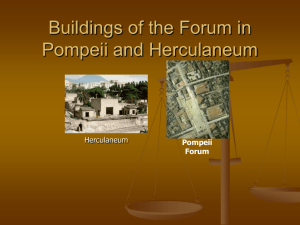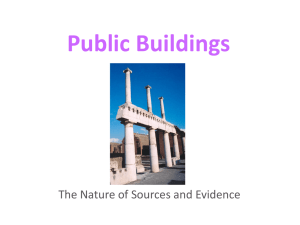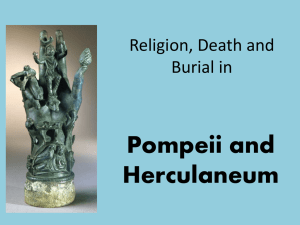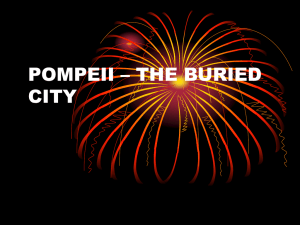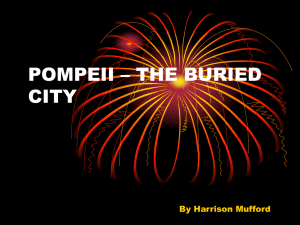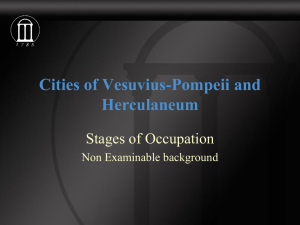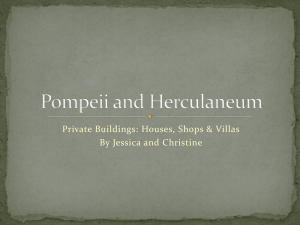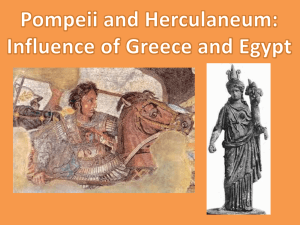Public Buildings in Pompeii and Herculaneum
advertisement
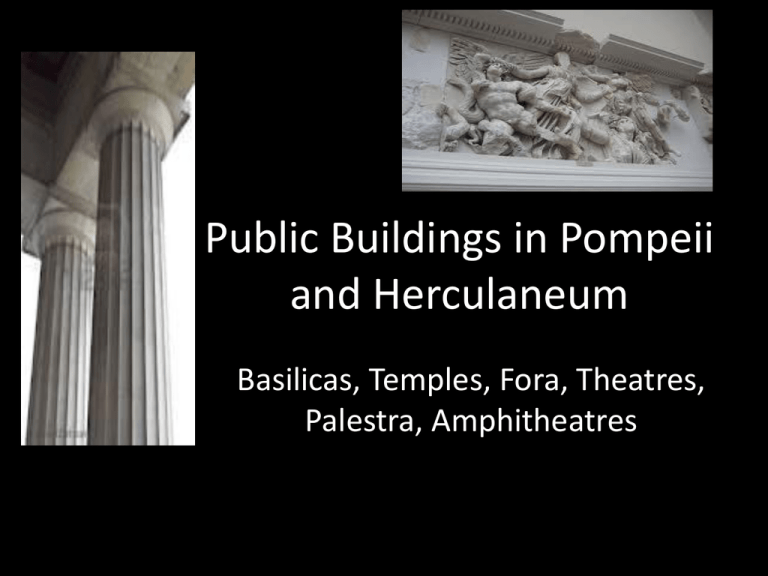
Public Buildings in Pompeii and Herculaneum Basilicas, Temples, Fora, Theatres, Palestra, Amphitheatres The Basilicas Pompeii: The Basilica stands near the west corner of the Forum and is the oldest and most important public building in Pompeii. Measuring 24 x 65 metres, it was built between 120 and 78 B.C. and is the best example in Pompeii of pre-Roman architecture. Many of the features of the Forum fit into conventions of Roman architecture, obviously parts of the building were rebuilt over time. However, the main entrance to the Basilica is on the short side of the building, a Samnite, rather than a Roman convention. Exactly what the elevation of the basilica looked like is still open to debate, but these fragments led to a reconstruction by Ohr in his book Die Basilika in Pompeji in which the upper order columns are engaged into a masonry balustrade for half their height and above that are freestanding. Thus the building would have been lit by the spaces between the columns as shown in the elevation top right. There are precedents for this arrangement; for example the columns which run round the upper part of the atrium in the Samnite House in Herculaneum. The Basilicas Herculaneum: 250 years after its discovery, the true purpose of the 'Basilica' is still largely unexplained. Named 'basilica' by the excavators who first explored it, it has also been variously referred to as a 'temple, a 'forum' and a 'palaestra'. It may simply be a building dedicated to the Imperial cult, but, if so, it's certainly on a grand scale. Although still virtually completely buried save for part of its entrance porch (pictured below and lower left), this huge building was extensively explored and thoroughly looted by its early excavators. The 'basilica', measuring 68m by 40m, was built round a central court. Colonnaded on three sides, the exterior walls of the portico were decorated with arches flanked by engaged columns separated by niches containing bronze and marble statues. The interior of the portico was decorated in the fourth style above the cornice with scenes of lions and dolphins and heroic combat. In front of the side recesses were two bronze statues and, one of Augustus and the other of Claudius. The Temple of Isis in Pompeii There are about nine identified temples in Pompeii: spaces dedicated to state religion, foreign cults and household worship. The Temple of Isis is one of the most well documented and well preserved of these spaces. The temple dates from the 2nd century BC and was dedicated to the Egyptian goddess Isis, whose cult was widespread throughout the Roman Empire. The entrance , which opens off the south side of the Via del Tempio d'Iside, bears a dedicatory inscription to its reconstruction after the earthquake of AD62. The reconstruction was financed by the freedman Numerius Popidius Ampliatus in the name of his son Celsinus. The entrance opens onto a courtyard surrounded by a four sided portico. The portico was decorated in the fourth style with red panels (shown below) containing priests in ceremonial dress and Egyptian landscapes separated by architectural themes with small Nilotic scenes or naval battles all above a lower orange frieze of lionesses, sphinxes, dragons and dolphins. The upper zone contained floating temples and small paintings of landscapes and still lifes on a white ground. n the south east corner of the complex a series of rooms (I) open off the south side of the portico. These rooms were the living quarters (Pastophorion) of the priests and include a kitchen, triclinium and cubiculum. The Sacred Area of Herculaneum The Sacred Area lies to the west of the Terrace of M. Nonius Balbus, accessed off a passageway at its eastern end where the ramp from Cardo IV joins the terrace. This western terrace contains two sacred spaces at its westmost end and, like the adjoining Terrace of M. Nonius Balbus, was built over vaulted boat houses lining the ancient shore. Past some rooms that were possibly used for storage, the first of the two temples (b) was dedicated to Venus (pictured above and below). The building was completely restored after the earthquake in AD62, the restoration being funded by Vibidia Saturnina and her son A. Furius Saturninus. The second temple (c), also restored after AD62, was dedicated to the four gods Vulcan, Neptune, Mercury and Minerva as evidenced by the neo-Attic reliefs which were torn from the building by the force of the pyroclastic flow. The reliefs were recently rediscovered and copies have been placed in the cella. Like the adjoining temple, the cella is on a raised podium, which was framed by Corinthian columns. The Forum of Pompeii The Forum was the centre of Pompeii when it was first founded and even after the city's enlargement, when it could hardly be called 'central', it remained the focus of political, economic and religious life. The Forum was quite large, measuring 157 x 38 metres and, together with the surrounding public buildings could contain all the inhabitants of the city. The colonnade was built round the Forum in the Samnite period. The Forum was arcaded on three sides, the exception being the north side which comprised a building, the Temple of Jupiter, and two honorary arches. On the south side of the Forum were all the buildings involved in Pompeii's public life; the Basilica, the Municipal Offices and the Comitium. The Municipal Offices comprised the Offices of the Aediles nearest the Basilica, the Curia in the centre of the group of three buildings and finally the Offices of the Duoviri near the Comitium. Two honorary arches flank the Temple of Jupiter. The western arch, situated at the height of the temple colonnade, was dedicated to Drusus; it originally had a pendant arch on the other side of the temple, which was torn down so as to leave a view of the arch behind, attributed to either Tiberius or Germanicus. The Triangular Forum of Pompeii The Triangular Forum takes its name from the unusual shape of the site. The forum sits on the edge of a spur of ancient lava and was probably laid out during the Samnite period to enhance the setting of the Doric Temple that occupied the southern part of the site. A colonnade of the Doric order was built along the west and north east sides and, where the two arms of the colonnade met, a high portico of the Ionic order was erected facing the street, thus forming a monumental entrance to the forum and Large Theatre. The southern part of the forum contains the Doric Temple built in the 6th century BC. Two divinities, Hercules and Minerva, represented in some of the antefixes, were probably worshipped here. Directly in front of the temple, at the foot of the steps in the location ordinarily occupied by the principal altar, is a small enclosure fenced in by an outer wall and a low inner wall. Judging by its form, it is probably a commemoration of the mythical founders of the city. Theatres of Pompeii and Herculaneum Pompeii: The Large Theatre, from the character of its construction, dates in its original form from the end of the 3rd century BC. During the Augustan period the theatre was extensively restored and enlarged under the auspices of the brothers Marcus Holconius Rufus and Marcus Holconius Celer as testified in the many inscriptions found throughout the building. The architect employed by the Holconii was a freedman, Marcus Artorius Primus imortalised in an inscription on the outer wall near the entrance to the orchestra. Herculaneum: One of the first finds at Herculaneum was its theatre, first discovered in 1709 whilst digging a well. This is only about half the size of the theatre in neighbouring Pompeii, but considering the population of Herculaneum could not have been much more than 5,000, its capacity was more than adequate. The theatre was decorated with many kinds of marble. Of these, all have been lost, not so much by the violence of the eruption as by the rapacity of the excavators. Every part of the building, inside and out, was decorated with statuary. When the mud torrent rushed down, it destroyed much beyond recognition. Palaestras of Pompeii Main Pompeii: The Palaestra is situated to the south of the Via dell'Abbondanza in the eastern quarter of the city next to the Amphitheatre. The Palaestra was built during the Augustan period and occupies an enormous area of approximately 140 x 130 metres. It consisted of a central area for sporting activities surrounded by a high wall with entrances to the east and west. On the inside, along three sides, was a portico of Ionic columns. The palaestra had been badly damaged in the earthquake of 62 AD and like many other buildings in Pompeii was still being rebuilt at the time of the eruption. Samnite Palaestra: The Samnite Palaestra lies on the south side of the Via del Tempio d'Iside between the entrance to the Triangular Forum and the Temple of Isis. The entrance opens onto a court which was originally entirely surrounded by a colonnade with ten columns on the sides and five at each end. At a comparatively late date, probably soon after the earthquake of AD62, the columns at the east end of the court were removed and the space thus gained added to the neighbouring Temple of Isis. Amphitheatre The amphitheatre lies to the south of the Via dell'Abbondanza near the Sarno Gate. It was completed in 80BC, having been commissioned by two magistrates, C. Quintus Valgus and M. Porcius (these two magistrates also commissioned the Small Theatre, or Odeon). An impressive structure, the amphitheatre measures approximately 135 x 104 metres and could hold about 20,000 people. It is the earliest surviving permanent amphitheatre in Italy, and is therefore particularly important in providing a picture of this type of typically Roman architecture. Inscriptions inform us that the two niches on either side of the north corridor housed statues of Caius Cuspius Pansa and his son. They both held important civic offices, including those of duoviri and were honoured for having restored the amphitheatre after the earthquake of AD62.

